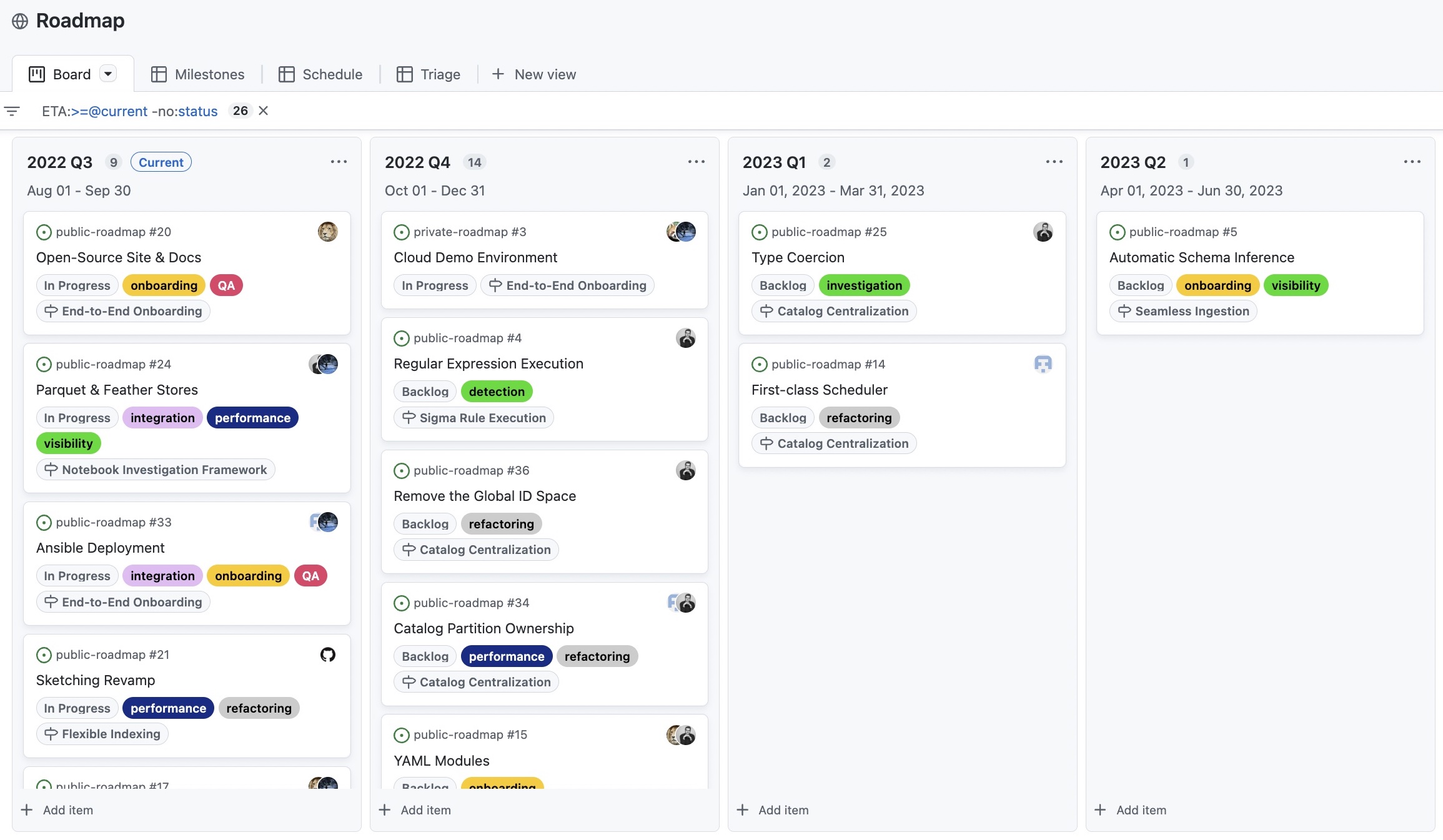We are happy to announce that we have published our engineering roadmap along with an RFC process to actively participate in shaping upcoming topics. This blog post explains why and how we did it.
As a community-first open-source project, we constantly strive for increasing transparency. Our long-term goal is establishing a fully open governance model. This will allow for a clear delineation of the open-source project and unbiased commercial offerings that we, the engineering team behind VAST at Tenzir, provide on top. Until we have bootstrapped ourselves and an active community, we aim for the right balance between open and closed.
One step in the direction of open is publishing our roadmap and enabling the community to participate in the planning through an Request For Comments (RFC) process.
Public Roadmap
In the process of opening the roadmap, we had to answer several questions:
Audience: should the content be for users only? What about developers? Should we only mention features or also refactorings?
Interaction: should this just be a read-only page or something the community can directly interact with?
Tooling: what is the right tool to encode the roadmap?
Let's go through them one by one.
Regarding audience, we want to avoid an overly narrow target group, as we are in phase of growth where breadth instead of depth is more important. Moreover, we gain more transparency if we can unveil all ongoing thrusts. Therefore, we want to cover the full spectrum of personas, but make it possible for each individual type of persona to get a relevant view.
Regarding interaction, we are actively looking for engagement. Throwing a read-only version over the fence to the community is certainly informational, but we are looking for creating dialogue. Therefore, we want to allow everyone to discuss the various roadmap items in the open.
Regarding tooling, we are in need for something that integrates well with the existing environment. Our GitHub presence includes code, documentation, website content, and third-party integrations. We also promote use of GitHub Discussions to engage with us. This makes GitHub the focal point to engage with the content. Therefore, we decided to encode the roadmap as GitHub issues; for clarity in a dedicated repository at https://github.com/tenzir/public-roadmap.
We decided against dual-purposing the issue tracker of our main repository https://github.com/tenzir/vast because it would add roadmap items as many open, long-running issues that scatter the attention and potentially confuse the community. That said, the primary value of the issue tracker is the layer on top of issues: GitHub Projects, which allows for organizing issues across multiple dimensions in a visually appealing way.
The quarterly board view make it easy to understand ongoing thrusts:
The milestones view provides a different perspective that focuses more on the bigger-picture theme:
Open RFCs
The roadmap provides a lens into the short-term future. We don't want it to be just read-only. Fundamentally, we want to build something that our users love. We also want to tap into the full potential of our enthusiasts by making it possible to engage in technical depth with upcoming changes. Therefore, we are establishing a formal Request for Comments (RFC) process.
To get an idea, how an RFC looks like, here's the RFC template:
# Proposal Name
- **Status**: WIP | In-Review | Approved | Obsolete
- **Created**: Aug 19, 2022
- **ETA** | **Accepted** | **Dismissed**: Sep 20, 2022
- **Authors**:
- [First Last](https://github.com/username)
- **Contributors**:
- [First Last](https://github.com/username)
- **Discussion**: [PR #2511](https://github.com/tenzir/tenzir/pull/2511)
## Overview
A short summary of the proposal contents.
## Problem Statement
A description of the problem this proposal solves.
## Solution Proposal
A proposal of the solution that addresses the problem.
## Implementation
The technical details the make the solution viable.
## Alternatives
What alternatives may exist and why are they not an option?
RFC-001: Composable Pipelines is an example instantiation of this template.
The RFC reviews take place 100% in the open. As of today, reviewers constitute members from Tenzir's engineering team. Given our current resource constraints and project state, we can only support a corporate-backed governance model. That said, opening ourselves up is laying the foundation of trust and committment that we want to go beyond a walled garden. We understand that this is a long journey and are excited about what's ahead of us.
When an RFC gets accepted, it means that we put it on the roadmap, adjacent to existing items that compete for prioritization. In other words, even though we accepted an RFC, there will be an indeterminate period of time until we can devote resources. We will always encourage community-led efforts and are enthusiastic about supporting external projects that we can support within our capacities.
These are our "growing pains" that we can hopefully overcome together while building a thriving community. We still have our community chat where we are looking forward to interact with everyone with questions or feedback. See you there!


